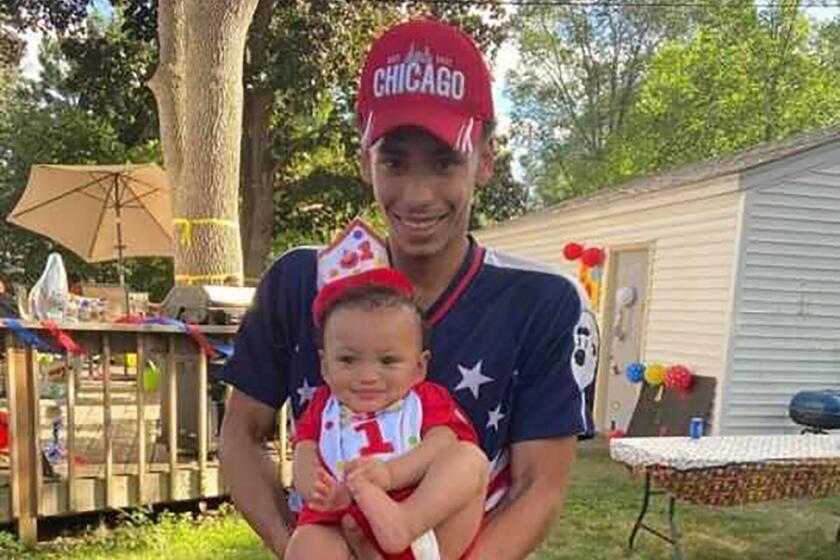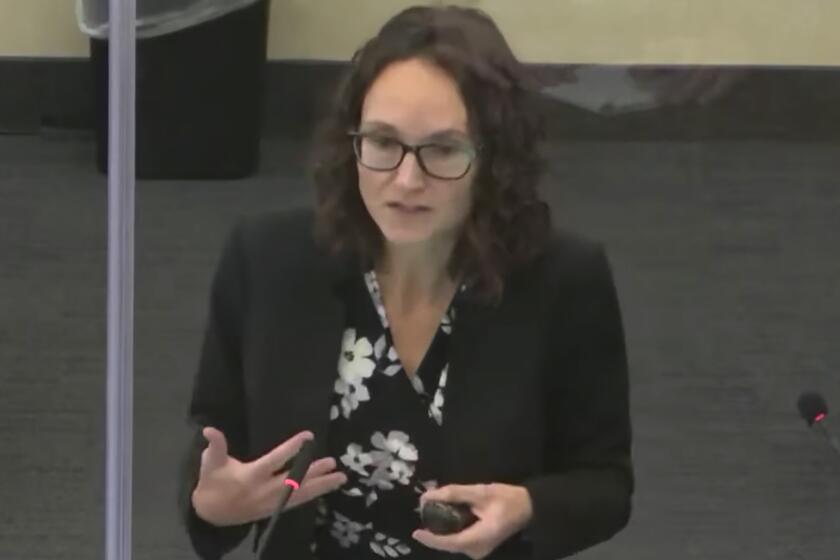Kim Potter, police officer who killed Daunte Wright, testifies tearfully at her trial

- Share via
MINNEAPOLIS — The suburban Minneapolis police officer who shot and killed Daunte Wright testified at her manslaughter trial Friday that she wouldn’t have pulled over his car if she hadn’t been training another officer, and that she hadn’t planned to use deadly force that day.
Under questioning by a prosecutor, Kim Potter sobbed during her sometimes emotional testimony, saying at times, “I didn’t want to hurt anybody,” and later, “I’m sorry it happened.”
Potter was the final witness before the defense rested at the end of the second week of testimony. She said she shot Wright, 20, on April 11 in Brooklyn Center in a moment of chaos, after he tried to leave the scene as she and other officers were trying to arrest him on an outstanding warrant for a weapons violation.
Potter, 49, said she meant to use her Taser to subdue Wright when he pulled away from the officers and got back into his car, but shot him once with her handgun instead.
Potter’s attorneys argued that she made a mistake but also would have been justified in using deadly force if she had meant to because another officer was at risk of being dragged by Wright’s car. Potter testified that she decided to use her Taser because of the scared look she saw in one of the other two officers’ eyes.
Potter said she yelled, “Taser!” repeatedly so the other officers, who were trying to get Wright out of his car, would disengage.
Prosecutors say Potter was an experienced officer who had extensive training in the use of Tasers and deadly force, and that her actions were unreasonable.
During cross-examination, prosecutor Erin Eldridge drove hard at Potter’s training, getting her to agree that her use-of-force training was a “key component” to being an officer. Potter testified that she was also trained on when to use force and how much to use, and that there was a policy that dictated what officers could and could not do.
Potter was shown photos of her Taser and firearm next to one another. The Taser was yellow and her gun was Black. Eldridge noted that the loaded gun is heavier than the Taser.
“So you went out on the street with a Taser, not knowing what that Taser did?” Eldridge asked Potter.
“I would assume that on the day I worked, I would know. But I don’t know — it’s been months now,” Potter responded.
Prosecutors have rested their case against Kim Potter, the former Minnesota police officer charged in the shooting death of motorist Daunte Wright.
Potter testified under questioning by one of her lawyers that she‘d had no training on “weapons confusion,” saying it was something mentioned in training but not something her department’s officers were physically trained on. She also said she had never used a Taser while on duty during her 26 years on the force, though she had pulled it out a few times, and that she had never used her gun until the day she shot Wright.
Potter, who was training Officer Anthony Luckey that day, said Luckey noticed Wright’s car in a turn lane with the signal turned on inappropriately, then saw an air freshener hanging from the rearview mirror, a violation, as well as expired tags.
She said Luckey wanted to stop the vehicle, though she would “most likely” not have done so if she’d been on patrol by herself, citing the lengthy delays Minnesota drivers had experienced trying to renew vehicle tags at that point in the pandemic. But she said that once they learned that Wright had a bench warrant for a weapons violation, they were required to arrest him because the warrant “was an order of the court.”
She said they were also required to find out who Wright’s female passenger was because a woman — a different one as it turned out — had a restraining order against him.
While defense attorney Earl Gray walked Potter though what happened that day, he did not ask her whether she meant to draw her Taser. A prosecution witness had testified earlier in the week that she would not have decided to use her Taser if she thought there was a danger it could cause a death or great bodily harm.
Potter, who resigned two days after the shooting, broke down in tears as she said the traffic stop “just went chaotic” after Wright tried to get back into his car and leave. She wept when she described the shooting and became emotional when Eldridge played video of her pointing her gun at Wright. For most of the cross-examination, she was matter-of-fact and gave brief answers.
Under questioning by her own attorney, Potter said she didn’t remember everything that happened after the shooting, including what she said or being in an ambulance.
“So much of it is missing,” she said of her memory.
She said she had been in therapy since the shooting and that she had left Minnesota. No longer a police officer, she said she had quit the force because “there was so much bad things happening.... I didn’t want anything bad to happen to the city.”
Before Potter took the stand, a psychologist called by her lawyers testified that police officers can mistakenly draw their guns instead of their Tasers under high-stress situations because their ingrained training takes over.
Laurence Miller, who teaches at Florida Atlantic University, said Friday that the more someone repeats the same act, the less he or she needs to think about it, but that during a stressful situation their normal reactions can be “hijacked.”
Wright’s killing set off angry demonstrations for several days in Brooklyn Center. It happened as another white officer, Derek Chauvin, was standing trial in nearby Minneapolis for killing George Floyd, who, like Wright, was Black.
Miller said that when a person learns a new skill, memory of an old skill might override that, resulting in an “action error” in which an intended action has an unintended effect.
“You intend to do one thing, think you’re doing that thing, but do something else and only realize later that the action that you intended was not the one you took,” he said.
A prosecutor at the trial of the Minnesota police officer who killed Daunte Wright told jurors that Kim Potter violated her training and “betrayed a 20-year-old kid.”
Some experts are skeptical of the theory. Geoffrey Alpert, a criminology professor at the University of South Carolina who is not involved in Potter’s trial, has said there’s no science behind it.
On cross-examination, Eldridge read to Miller from a 2010 article Alpert wrote in which he described how police can avoid what he termed “one big mistake.” He wrote that many such mistakes are preventable through proper training and practice.
The defense began its case on Thursday before Potter’s mostly white jury.
Associated Press writers Tammy Webber in Fenton, Mich., and Steve Karnowski in Minneapolis contributed to this report.
More to Read
Sign up for Essential California
The most important California stories and recommendations in your inbox every morning.
You may occasionally receive promotional content from the Los Angeles Times.















